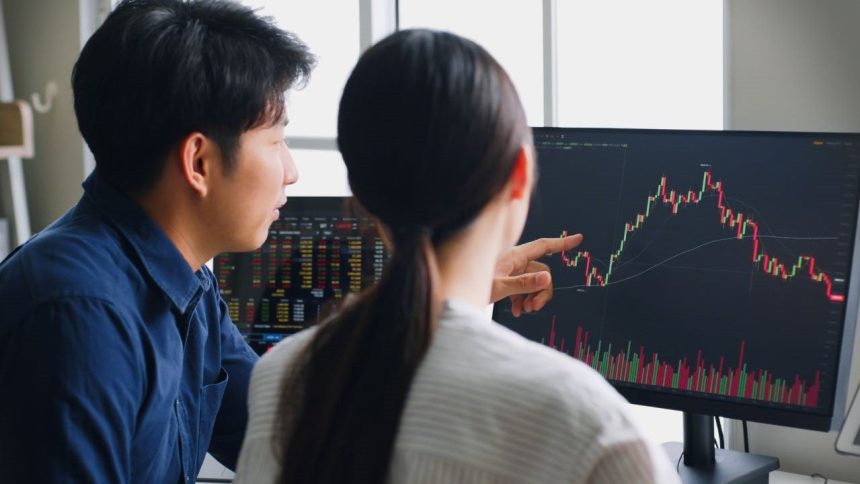Nattakorn Maneerat/Getty Images
Our writers and editors used an in-house natural language generation platform to assist with portions of this article, allowing them to focus on adding information that is uniquely helpful. The article was reviewed, fact-checked and edited by our editorial staff prior to publication.
A pump-and-dump scheme is a form of market manipulation and financial fraud in which members of a group buy a security and then convince others to buy it, too. The point is to illegally “pump up” the price of a stock, cryptocurrency or other type of hyped investment. But before long, the price rapidly retreats and the pump scheme quickly turns into a dump.
How a pump-and-dump scheme works
A pump-and-dump scheme usually goes like this: A group of insiders plans to buy a particular stock, like a penny stock, which are riskier types of equities. The insiders then spread false or misleading information about the company to increase the demand for the stock and drive up the price.
When the stock price is high, the insiders sell their shares, pocketing profits. But as soon as insiders sell their shares, prices drop dramatically. This is when the majority of investors, who bought on the rise, are left with plummeting or even worthless shares that they may not be able to liquidate quickly.
How to avoid pump-and-dump schemes
The best way to avoid a pump-and-dump scheme is to understand how these schemes work. Here’s how to recognize the warning signs and steer clear of them.
Know what to look for
Pump-and-dump schemes can happen in various types of investments. Always do your research to ensure you know what you’re investing in and that it’s legitimate.
If you’re considering putting money into a hot, new cryptocurrency for example, research the developers (the team behind the project) and any product or service being sold to investors. Look for reviews from third-party websites to get a sense of what others are saying about the project. If you have any doubts about the legitimacy of the investment, look to invest elsewhere.
Ask yourself if it makes sense
Pump-and-dump schemes are often based on hype and speculation rather than sound business or investing practices. For example, the sentiment behind a particular stock may not make much sense. The company might be in the red or have minimal revenue, but the stock price suddenly shoots up. If you can’t explain why the price is rising, it might be a sign that the price is too high or that you’re looking at a pump-and-dump scheme.
Use common sense
Remember that when you invest, you’re betting on the future of the company. Be wary of companies that are not yet profitable and ask yourself why you’d consider investing in them.
It’s also important to remember that stocks can rise and fall. If you’re looking at a stock with a high price, keep in mind that stocks can also drop and you might soon face losses.
Consider the source of the hype
A pump-and-dump scheme relies on excitment and a heightened sense of urgency. The hype often comes from a third party, such as a newsletter or social media account. If you’re looking at an investment and the person who’s promoting it isn’t someone you trust, the hype may be part of the scam.
Do your homework before you invest
Pump-and-dump schemes rely on investors who are willing to believe that a stock will run up in price. By doing your homework, you can identify whether a stock is likely to be a good or poor investment.
Look at a company’s financial statements and earnings reports to learn if the company is making money and if it’s on a trajectory to grow. You’ll also want to look at the competitive landscape to determine how well the company can compete.
Watch for warning signs of a potential pump-and-dump scheme, such as high valuations or a lack of earnings.
Be cautious of “hot tips”
Pump-and-dump schemes rely on a heightened sense of urgency and a fear of missing out (FOMO). These schemes rely on people wanting to get in on the action and fearing that the opportunity will soon pass them by if they don’t act.
You can also avoid falling for a pump-and-dump scam by steering clear of little-known investments and opt for buying a few of the best performing stocks or the best index funds instead.
Bottom line
Pump-and-dump schemes are a common form of market manipulation and fraud that can result in major financial losses for unsuspecting investors. To avoid falling victim to these scams, it’s crucial to do your own research, use common sense and be cautious of hyped-up investments. Remember to always consider the source of the hype and thoroughly analyze a company’s financials before investing. In short, don’t let the fear of missing out lead you into making hasty and potentially costly investment decisions.
Editorial Disclaimer: All investors are advised to conduct their own independent research into investment strategies before making an investment decision. In addition, investors are advised that past investment product performance is no guarantee of future price appreciation.
Read the full article here
















